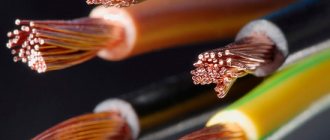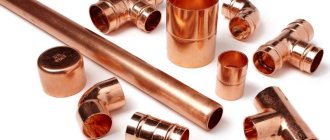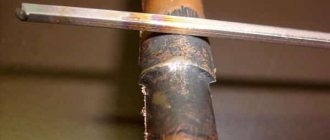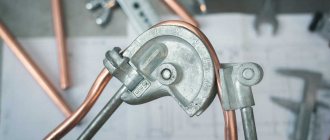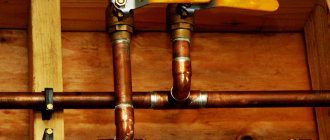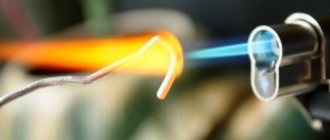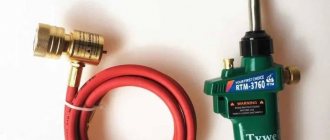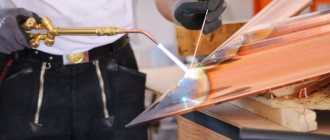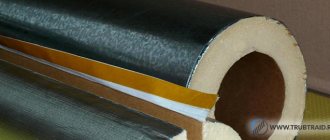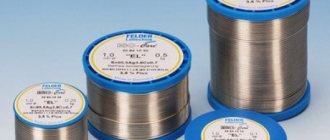Flux is a chemical substance that is used when soldering, in particular, copper pipes and helps to better fill the joint space with solder. Flux also performs another very important function - it cleans the metal product from contaminants and oxidation products. In addition, it forms a protective film that prevents the seam from coming into contact with oxygen.
Soldering copper pipes requires the use of special materials, one of which is flux
Copper pipeline soldering technology
Copper pipes are used for the installation of various communications: water pipes, heating systems and gas pipes. They have a number of advantages, such as:
- are resistant to the harmful effects of corrosion;
- the surface of copper pipes is quite smooth;
- UV resistant;
- have a high thermal conductivity coefficient;
- able to withstand high temperatures;
- have good strength;
- The service life of a copper pipeline reaches 50 years.
Note! The main disadvantage of such a pipeline is its relatively high cost, however, copper material remains popular as it is very reliable and durable.
Soldering is used to connect individual elements of a copper structure. Its varieties are as follows:
- soldering at high temperature;
- soldering at low temperature.
High-temperature soldering is used to obtain a joint with increased strength. Low-temperature soldering is used in all other cases.
For soldering with refractory solders
Soldering of copper in certain situations is carried out with solders that melt at high temperatures. Only borax or a mixture of borax and boric acid can be used as a flux in these processes.
A solution of borax and boric acid in water with zinc chloride or a mixture of borax, boric acid and calcium fluoride is also used.
The solders used in this type of soldering are alloys containing copper. To ensure the quality of the connection, the borax must be well calcined before making fluxes yourself. In ready-made products, all components have undergone pre-processing.
Features of soldering with flux
If we compare soldering using flux and arc soldering, in the first case the performance will be higher. The use of flux when soldering copper pipes allows the use of increased current density. The use of high currents, in turn, affects the depth of pipe melting. At the same time, you should not worry that the electrode will lose its coating material due to high temperatures.
The use of flux allows you to obtain a denser and more uniform seam
The use of flux allows you to avoid a large number of foreign inclusions, since pores do not form in the seam during soldering. Before purchasing flux for soldering copper pipelines, it is advisable to pay attention to its distinctive features. For example, to eliminate the possibility of the appearance of an oxide film, the following measures must be taken:
- Monitor the soldering temperature of soft solder for copper pipes and joints until the temperature is the same. When choosing a flux, you should pay attention to its performance. This indicator depends on the type of solder.
- If it is possible to achieve temperature uniformity between the soft joint and the solder, it can be used as a device that measures changes in temperature, which eliminates the possibility of overheating during soldering.
When purchasing a suitable solution for a particular case, you should pay attention to its quality.
Moderately corrosive compounds
Fluxes made from rosin to which alcohol is added with any of the following substances are characterized by low corrosive activity:
- acetic acid,
- zinc chloride,
- orthophosphoric acid.
When soldering, a copper flux made from a solution of rosin in alcohol with the addition of zinc and ammonium chlorides works well. It is effective to use a mixture of glycerin and a solution of zinc, ammonium, and sodium chlorides.
A high-quality connection during soldering is ensured by a flux made from a solution of glycerin in water, to which hydrazine hydrochloride is added. You can successfully use a mixture of alcohol and phosphoric acid solution.
Fluxes containing rosin are used at temperatures up to 300 °C. Other compositions can be heated to 350 °C.
What characteristics should a flux have for soldering copper pipes?
A high-quality flux used for soldering copper pipelines must meet certain requirements. Let's look at them:
- Regardless of the type, the composition must be evenly distributed over the working surface;
- the viscosity and density of this substance should be less than that of solder. This is necessary for substitution to occur;
- the flux must dissolve the oxide film and prevent re-oxidation of the copper part;
- in addition, such a substance should ensure a neat appearance of the seam;
- the composition should not be destroyed as a result of exposure to high temperatures;
- after soldering is completed, dirt and dust should be easily removed;
- The flux must allow soldering in both vertical and horizontal areas.
A high-quality flux in the form of a paste should be viscous and dense, then it will be evenly distributed over the surface of the pipe
A high-quality flux must have all of the above characteristics. After soldering is completed, this substance is removed using special solvents.
Solder paste. Soldering.
Since I receive a large number of questions, today I want to talk in detail about a very convenient, but still unfamiliar to many, solder in the form of a paste. I think that this information will be useful for everyone who is not yet familiar with this solder. Solder is a ready-to-use mixture of solder, connecting paste and flux. Supplied in syringes with special nozzles (applicators) for dosed supply of solder. There are special compounds for copper, brass, and silver. They differ in the percentage of their components, composition and, therefore, differ in the color of the seam. But the operating principle of all these solders is the same. Getting started : The surfaces to be soldered must be cleaned of oxides and be in contact with each other as closely as possible. It is better that the gap between the parts is not visible to light at all. The photo shows a copper plate 0.4 mm thick, to which we will solder a cast 3.18 mm wide and 0.3 mm thick.
There is no need to apply flux to the soldering area, because... it is already present in the paste. Solder is applied through an applicator. You can use a sausage strip (as in the photo below), or you can use a snake. For example, sometimes I just squeeze out a little paste from a syringe and apply it with a titanium stick, or, if it’s hot, with a regular wooden toothpick.
Attention! Do not touch heated parts with the applicator. The solder in the applicator instantly sets and will have to be cleaned with a thin wire under running hot water.
Then we begin to warm up the entire product with a burner using smooth circular movements. In the solder, first the connecting paste smokes, burns and burns out (it is advisable to work in a ventilated area), then the flux begins to flow (like oil - a dark spot) And then, on the red-hot metal, the solder begins to melt (shiny, sparkling). As soon as it starts to float and flow, remove the burner. The photo shows solder after soldering.
Immediately after whitening, the soldering looks like this:
After chilling, the product is processed, traces of solder are removed, the product is ground, polished, and patinated.
A short video of the slow soldering process. It clearly shows all stages of solder melting.
As correctly noted in the comments, much less solder is needed for soldering. In the video, an excessive amount of it is used to illustrate the process.
And further:
The two most common soldering problems are:
1. The solder spread, but the parts were not soldered. Reasons: - the parts were not tightly fitted to each other. - you overheated one of the parts and all the solder “wasted” on it.
Do not forget that the molten solder spreads over the surface not left and right or back and forth, but only in the direction of the greatest heating of the metal. Therefore, if, for example, you are soldering a small element to a massive base, you need to make sure that both parts are heated equally. If a small element gets hotter than the base, all the solder may flow onto it without filling the seam.
2. The solder did not spread, but smoked, dried and became crumbly and clay-like. There is no seam. Reason: - insufficient heating temperature of the metal. It is necessary to increase either the burner power or the heating time.
Please note!
The melting point of solder is about 700 degrees Celsius (we will not take into account solidus and liquidus). Therefore, the burner must have the power to heat the surfaces of the parts being soldered to at least this temperature. Any solder should melt not from the flame of the burner, but from the temperature of the metal being soldered heated by the burner. Small torches with piezo ignition such as a pencil torch, Dremel, etc. Only small parts can be soldered! Therefore, it is better to buy them later, if necessary. The middle ring or pendant will be easier and more convenient to solder with torches of the Proxxon, Blazer, etc. class. There are many high-quality Chinese burners on sale. It is advisable to start working with approximately these burners.
You can “increase” the power of the burner by placing the product on a surface with good heat transfer (carbon, porous or honeycomb soldering block). Or make a kind of “cave” by covering the soldering area on three sides with non-flammable material (pieces of the same blocks for soldering). In order to solder larger things, for example, a bracelet, you will need more powerful torches: from the budget ones, a nozzle with piezo ignition and adjustment is well suited gas These are now sold in large quantities in stores.
Or it can be gasoline, injection propane (such as ORCA) or oxygen (propane/oxygen). But, this is a completely different topic. If you still have any questions, write and we’ll discuss it.
Types of fluxes
All fluxes differ from each other in various respects, but most often in the elements included in their composition. In order to clean the metal to be soldered from contaminants, the following types of fluxes are used:
- boric acid;
- zinc chloride;
- hydrochloric acid.
And to create a film that will perform protective functions, you can use:
- rosin;
- wax;
- various resins.
When soldering copper pipes, various types of fluxes can be used:
- liquid;
- powder;
- flux paste.
Liquid compositions are usually stored in closed tubes and used together with solders that have a soft consistency. Powder fluxes are less popular due to the inconvenience associated with their use during soldering. Pastes for soldering copper pipes are more expensive, however, they are sold ready-made and can be used immediately. Soldering paste allows you to simplify the process and get an incredibly strong and reliable adhesion of pipes.
Ready-made pastes are easy to use, but are more expensive than other products
Today there are a huge number of varieties of this substance. However, there are three most popular types that are used for soldering, including copper pipes:
Anti-corrosion compounds. Such substances not only perform the function of cleaning the surface from oxidation, but also remove water from the soldering area, displacing it. Using this composition allows you not to remove residues after soldering. It is quite difficult to make such a solution at home.
Compositions based on salicylic acid. In such fluxes, the main active substance is dissolved in a composition that consists of various chemicals: alcohol, petroleum jelly (technical), gold-containing substances. Such fluxes are produced only in industrial conditions and are quite popular, as they affect the quality of the seam. The seam after soldering a pipe using this flux turns out very smooth.
Helpful information! This composition can be made with your own hands at home. As a basis, you can take acetylsalicylic acid (aspirin) tablets and mix them with technical petroleum jelly and alcohol. However, such a flux will have very little heat resistance and is more suitable for soldering various electrical equipment.
Classic rosin. When assembling pipeline communications, rosin is not used in its pure form. Most often, sodium salt is mixed with it, and the result is a substance that has excellent protective and anti-corrosion characteristics for working with pipelines. Rosin envelops the seam with a protective film, and sodium salts prevent oxidative processes. This composition is cheap and is the most popular today. However, this flux also has a drawback - if it overheats, it can become charred. In addition, the seam when soldering with rosin is not as aesthetically pleasing as in the case of salicylic acid-based flux, but strong and reliable.
Rosin is the most affordable and popular material for soldering
Flux - features and purpose
Flux is a specific technical material for soldering copper pipes. Protects the surface of parts from oxidation and slag. Prevents contact of the welded seam with oxygen. Improves the overall quality of the joint and gives it good strength and optimal ductility.
In the room where copper pipes are sealed, it is necessary to organize high-quality ventilation. It is better to remove combustible and flammable substances in advance so that an accidental spark does not cause a fire or any other incident dangerous to human health.
Fluxes for soldering copper pipes are available in different consistencies.
Among the most sought after and popular:
- paste;
- powder;
- liquid.
The substance in the form of a paste for soldering copper pipes is more expensive than other materials, but fully justifies its high price. Suitable for use immediately after purchase and does not require the technician to add anything to the composition to improve its performance.
The paste is purchased for critical soldering, which requires the most precise and high-quality sealing of the joint areas. The substance easily lies on the copper surface, adheres well to it and is well distributed over the treatment area during heating.
Flux paste is very simple and easy to use. Not only a specialized specialist with extensive practical experience, but also any home craftsman can work with it without any difficulties.
The finished seam looks neat and ensures the integrity of the adhesion of all fragments of the system. Residues of the substance are easily removed after completion of work.
Powder products are sold at a lower price and are well stored in special containers. Maximum efficiency is demonstrated in conjunction with reinforced, refractory solders. They are considered less convenient due to the difficulty of uniform application to the treatment area.
Liquid substances are sold in closed bottles. They have normal contact with soft solders and adhere easily to the copper surface, providing high bonding strength. To ensure a high-quality connection, liquid flux and solder are always used simultaneously and not separately.
Regardless of consistency, flux must be applied immediately after stripping the copper fragment. If this moment is ignored, the metal surface will again be covered with oxides and it will not be possible to process it evenly.
After flux treatment, parts should be soldered immediately. This will eliminate the chance of foreign particles penetrating the work surface.
To apply paste-like flux, a special brush with elastic bristles of medium length is required. There is no need to use too much of the substance. This will not affect the quality and strength of the connection in any way.
When connecting parts, care and attention must be exercised. Contact of flux on the skin provokes not only thermal, but also chemical burns.
If this does happen, you should immediately stop soldering and wash the substance off your skin with plenty of soapy water.
Requirements for the quality of fluxes
There are some requirements for fluxes for individual and industrial use.
The substance must meet the following criteria:
- lower structure density and viscosity indicators than solder (for correct replacement);
- ability to distribute evenly over the working surface;
- dissolution of the oxide film;
- prevention of re-oxidation of copper elements;
- resistance to aggressive high temperatures;
- the ability to carry out soldering on both horizontal and vertical sections of the communication system;
- creating a neat, aesthetic seam.
When using good quality fluxes, dust and dirt formed as a result of soldering are removed easily and quickly, without leaving any traces on the pipe element that spoil the appearance. The connection is reliable and maintains structural integrity for many years.
Fluxes based on powders and rosin must be prepared immediately before soldering. The working substance is mixed with anhydrite in a certain portion and immediately applied to the treatment area
Popular types of material
There is a wide range of fluxes for soldering copper pipes on the market.
The most popular substances are:
- with high anti-corrosion ability;
- with noble materials in the composition;
- based on rosin.
Anti-corrosion flux consists of several complex elements, solvents and phosphorus. During the heating process, they dissolve in the liquid, react and form organic components.
Protect the seam area from oxidation and premature corrosion. Promote the drainage of excess moisture from the soldering zone.
The use of flux in the process of soldering copper pipes prevents the formation of pores in the structure of the seam. The connection is solid and does not contain foreign inclusions that reduce the strength of the joint
In the second type of flux, the main active ingredient is salicylic acid. During use, it dissolves in a composition of ethanol, gold-containing substances and industrial petroleum jelly.
Creates a perfectly smooth, neat and aesthetic connecting seam that does not require additional complex processing. Does not damage the material of the pipe adjacent to the treatment area
Classic active flux contains rosin and a certain amount of sodium salt. The substance has pronounced protective characteristics and effectively protects the pipeline from corrosion. Rosin covers the seam with a thin and durable protective film, and sodium salt inhibits oxidative processes.
Mixtures that form acid or contain it initially clean the surface efficiently and remove the oxide layer. To prevent the metal from deteriorating in the future and to retain its basic physical characteristics, the treated area after soldering must be thoroughly washed
This flux is sold for a reasonable price and provides a strong, reliable connection. However, the finished weld remains highly visible and is immediately noticeable on the outer portions of copper piping.
Regardless of the type and basic composition, the flux must be applied as evenly as possible, avoiding even a millimeter gap. If any part of the metal does not have this coating, the pipe will begin to rust over time and will need to be replaced.
The main disadvantage of rosin-based flux is its thermal weakness. It does not tolerate high temperatures well and with constant overheating it becomes charred.
What kind of solder should I use to solder copper pipes?
There is a huge variety of solders for connecting individual elements of a copper pipeline using soldering. All of them are divided into two types according to consistency:
- hard (refractory);
- soft (low-melting).
The most popular for these purposes are low-temperature solders. They allow copper pipes to be joined at low temperatures, which eliminates the possibility of their deformation. But it is worth noting that the seams after such solder have rather low mechanical qualities.
High-temperature solders, unlike low-temperature solders, allow you to make the most durable pipe connections.
Important! It is recommended to use high-temperature solders only by experienced specialists who know all the intricacies of soldering copper products. An inexperienced person can simply burn through a copper pipe.
When low-temperature soldering, which is very popular when installing copper pipelines in domestic conditions, solders that do not contain lead are most often used. Lead-free solders provide mechanically resistant adhesion. Lead-free solders include: alloys of tin with bismuth, antimony, silver, etc. Tin in such solders contains about 95%, the remaining 5% comes from additional elements.
In domestic conditions, soft solder is most often used, which contains a large amount of tin.
For soldering at low temperatures, solder, which is an alloy of tin and lead, can be used; however, such material is not recommended for the installation of plumbing structures. This is because lead is a toxic material and can be harmful to the health of occupants.
To solder copper pipes, a special gas burner is used, which allows you to achieve maximum strength and reliability of the connection.
What is the process of soldering wires?
Soldering differs from welding in that during the work it is not the ends of the metal wires being connected that are melted, but only the solder. Soldering must be done with a soldering iron and flux. An alloy of metals (tin, lead, antimony, silver) that melt at a lower temperature is used as solder. Solder melted with a soldering iron spreads, fills the gap between the metal wires and hardens, forming a strong, unbreakable connection. Soldering is reliable not only from a mechanical point of view, but also from an electrical point of view: the contact resistance of the conductors in the junction box depends on the contact area of the parts being connected - the larger it is, the lower the resistance. This means that the wires heat up less and the connection is better.
Considering that a fire can be a consequence of poor contact, in hard-to-reach places it is more advisable to connect the wires by soldering, thereby eliminating the possibility of their disconnection. It is appropriate to solder conductors in the distribution box even if it is located above a suspended or suspended ceiling.
Gas torch for connecting copper pipes
A propane torch is used to connect individual components of copper communications and allows you to work with parts at temperatures from 550 to 2000˚C. In addition, the design of the burner allows you to adjust the flame, depending on the type of solder (high or low temperature).
This device heats up quite quickly - within 10-30 seconds. A huge advantage of such a burner is its portability. It operates without being connected to the mains, which significantly expands its capabilities.
This apparatus is classified depending on the mixture on which it operates:
- mixtures of gas and air;
- mixtures of gas and oxygen.
A mixture of gas and air is used to start household burners. Their characteristics include light weight and the same dimensions. They are used for soldering small sections of pipes. And the combination of gas and oxygen allows you to work with pipes of any diameter.
Copper pipes are soldered using a gas torch, which is compact in size
Safety rules for soldering copper pipes
Soldering copper pipes involves the use of soldering equipment, which requires the necessary skills. When working with soldering equipment, you should pay attention to the following safety rules:
- when sealing a pipe, it is strictly forbidden to hold a segment shorter than 30 cm in your hands under a stream of flame. This is due to the fact that copper is a very good heat conductor and you can get burned;
- If flux gets on your skin, you must immediately wash it off with water. Otherwise, you may get a chemical burn;
- When carrying out the soldering process with a torch, you need to take care of your clothes - they should only be made of natural fabrics;
- Before soldering a copper pipeline, care must be taken to ensure that the room is properly ventilated. This is necessary because the solder used to solder copper pipes emits harmful substances.
What is needed for soldering
To solder copper conductors, you will need the following devices, materials and tools:
- Electric soldering iron with a power of 80 watts or more
- Solder
- Flux
- Flux remover (neutralizer)
- Pliers
- Flux brush
- PVC electrical tape
- Heat shrink tube of suitable diameter
- Hairdryer
You can solder copper wires not only with an electric soldering iron, but also with other equipment: a propane torch for soldering copper pipes, a mini gas torch, or a gas soldering iron with a torch attachment.
A burner with a small torch is convenient in that it provides local heating of the twist without damaging the conductor insulation. Before using an electric soldering iron, its tip must be cleaned from oxides with a file or sandpaper. It is recommended to use POS-60 or analogues with a melting point of 190°C as a solder for copper.
Flux removes metal oxides, promotes better adhesion of solder and its uniform spreading over the surface. It is better to use water-based flux - it does not contain alcohol or acid, so it does not require subsequent removal. If you use orthophosphoric acid, liquid rosin or LTI-120 for this purpose, then the products must be removed from the surface after work - otherwise they will destroy copper parts over time.
Read also: What does Not dimmable mean?
